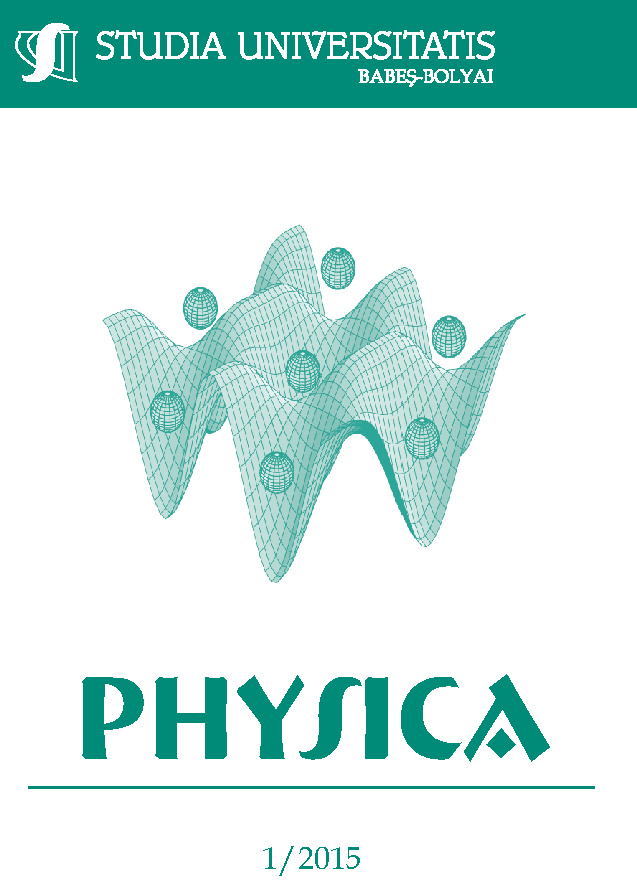STRUCTURAL PARTICULARITIES OF THE SILVER AND COPPER DOPED SiO₂–CaO–P₂O₅ BASED BIOACTIVE GLASSES
Keywords:
bioactive glasses, FT-IR, silver, copper.Abstract
Silver and copper oxidesdoped SiO2–CaO–P2O5 based bioactive glasses were obtained and structurally investigated taking into consideration their possible use as biomaterials for bone regeneration. The samples synthesized by the sol-gel method have shown the existence of a preponderantly amorphous structure, as indicated by the X-ray diffraction (XRD) data. The samples were further heat treated at 600 °C and investigated by means of XRD, Fourier Transform Infrared Spectroscopy (FT-IR) and UV-vis spectroscopy. The XRD data revealed features that can be associated with theexistence of apatite like crystallization centers. UV-vis absorption spectra indicate the presence of a small amount of metallic silver in the glass matrix, while the FT-IR spectra of silver and copper doped SiO2–CaO–P2O5 samples shown common characteristics to the bioactive glasses.
References
Vallet-Regi, M., Salinas, A.J., Arcos, D.,From the bioactive glasses to the star gels. J Mater Sci Mater Med, 2006. 17(11): p. 1011-7.
Anderson, J.M., The future of biomedical materials. J Mater Sci Mater Med, 2006. 17(11): p. 1025-8.
Jeffrey, B.C., and S.G. W., Sol-Gel Science - The Physics and Chemistry of Sol-Gel Processing. ACADEMIC PRESS, INC., 1990: p. 2-3.
Dutra, Z.E., The Formation of unusual glasses by sol-gel processing. Journal of Non-Crystalline Solids, 1992. 147&148: p. 820-823.
Polak, J.M., Bishop, A.E.,Stem cells and tissue engineering: past, present, and future. Ann N Y Acad Sci, 2006. 1068: p. 352-66.
Sooraj, H.N., L.M. A., and S.J. D., A comparative study of CaO-P2O5-SiO2 gels prepared by a sol-gel method. Materials Chemistry and Physics, 2004. 88: p. 5-8.
Aguiar, H., Solla, E.L., Serra, J., Gonzalez, P., Leon, B., Almeida, B., Cachinho, S., Davim, E.J.C., Correia, R., Oliveira, J.M., Fernandes M.H.V., Orthophosphate nanostructures in SiO2–P2O5–CaO–Na2O–MgO bioactive glasses. Journal of Non-Crystalline Solids, 2008. 354(34): p. 4075-4080.
Jones, J.R., Ehrenfried, L.M., Sarevanapavan, P., Hench, L.,Controlling ion release from bioactive glass foam scaffolds with antibacterial properties. J Mater Sci Mater Med, 2006. 17(11): p. 989-96.
Di Nunzio, S., Vitale Brovarone, C., Spriano, S., Milanese, D., Verne, E., Bergo, V., Maina, G., Spinelli, P., Silver containing bioactive glasses prepared by molten salt ion-exchange. Journal of the European Ceramic Society, 2004. 24: p. 2935-2942.
Magyari, K., Stefan, R., Vodnar, D.C., Vulpoi A., Baia, L.,The silver influence on the structure and antibacterial properties of the bioactive 10B2O3−30Na2O−60P2O2 glass. Journal of Non-Crystalline Solids, 2014. 402: p. 182-186.
Erol, M.M., Mourino, V., Newby, P., Chatzistavrou, X., Roether, J.A., Hupa, L., Boccaccini, A.R.,Copper-releasing, boron-containing bioactive glass-based scaffolds coated with alginate for bone tissue engineering. Acta Biomater, 2012. 8(2): p. 792-801.
Wu, C., Zhou, Y., Xu, M., Han, P., Chen, L., Chang, J., Xiao, Y.,Copper-containing mesoporous bioactive glass scaffolds with multifunctional properties of angiogenesis capacity, osteostimulation and antibacterial activity. Biomaterials, 2013. 34(2): p. 422-33.
Magyari, K., Baia, L., Vulpoi, A., Simon, S., Popescu, O., Simon, V.,Bioactivity evolution of the surface functionalized bioactive glasses. J Biomed Mater Res B Appl Biomater, 2014.
Bonici, A., Lusvardi, G., Malavasi, G., Menabue, L., Piva, A., Synthesis and characterization of bioactive glasses functionalized with Cu nanoparticles and organic molecules. Journal of the European Ceramic Society, 2012. 32(11): p. 2777-2783.
Baia, L., Muresan, D., Baia, M., Popp, J., Simon, S., Structural properties of silver nanoclusters–phosphate glass composites. Vibrational Spectroscopy, 2007. 43(2): p. 313-318.
Downloads
Published
How to Cite
Issue
Section
License
Copyright (c) 2015 Studia Universitatis Babeș-Bolyai Physica

This work is licensed under a Creative Commons Attribution-NonCommercial-NoDerivatives 4.0 International License.






